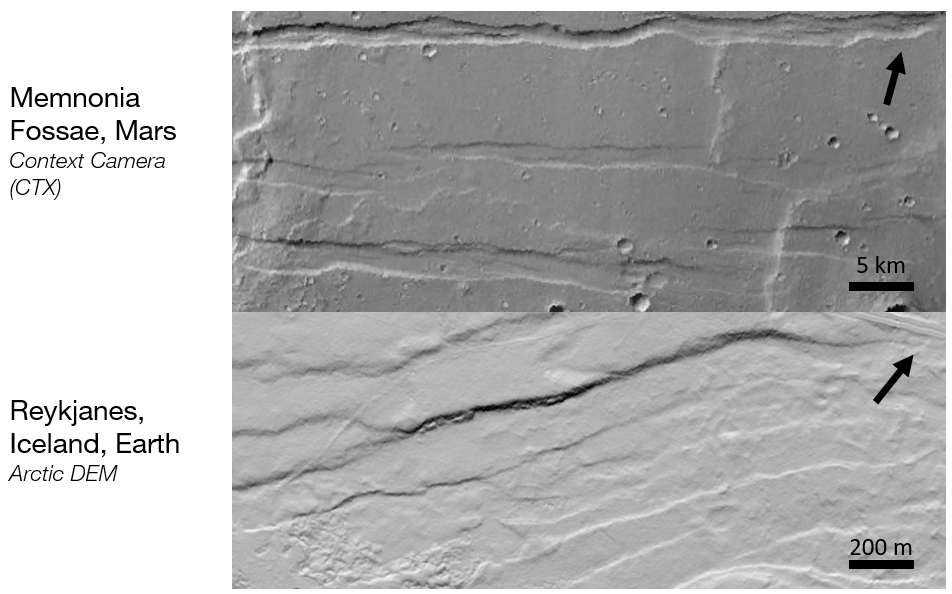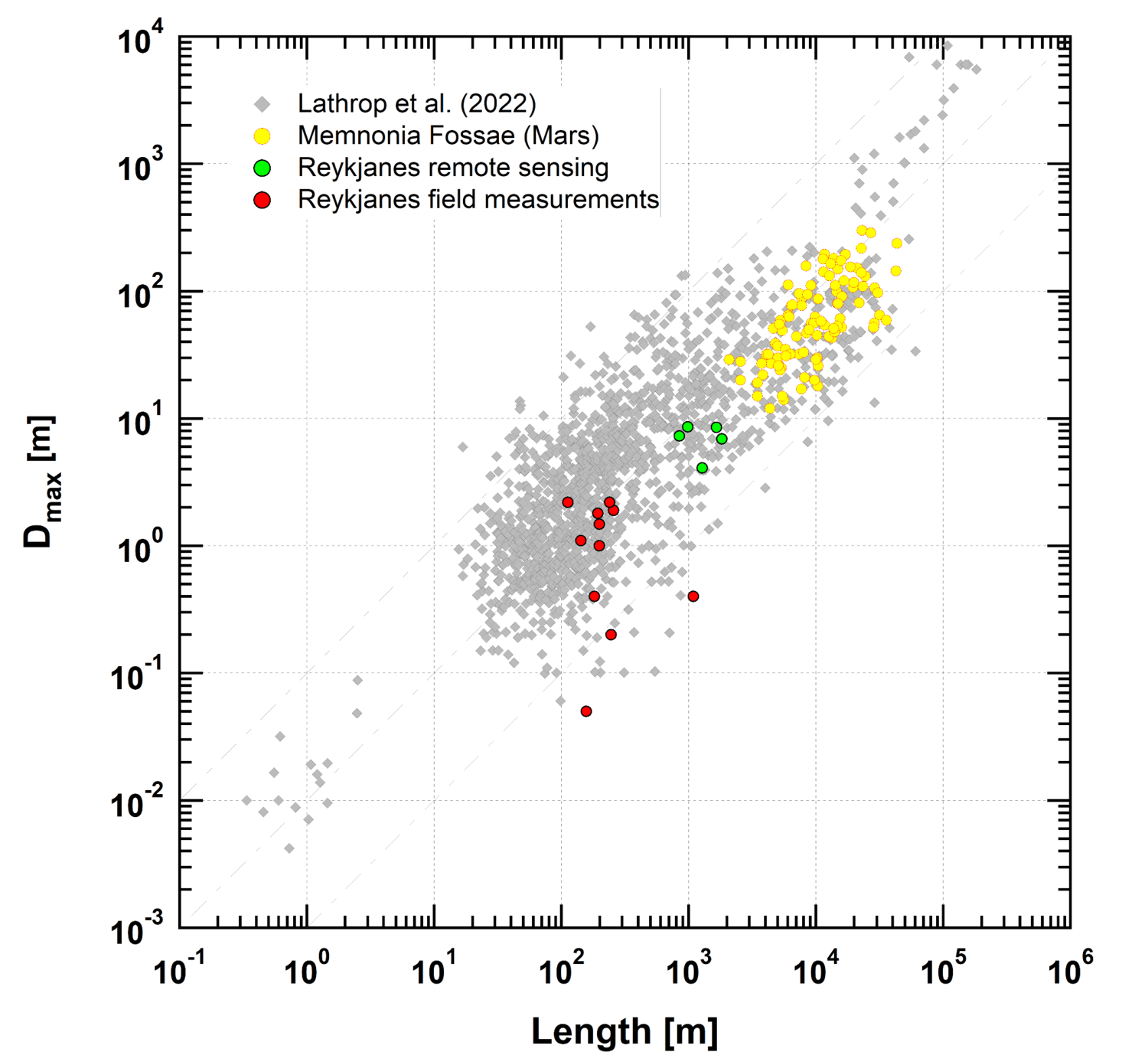Fault scaling at the Reykjanes Peninsula (Iceland) as a Mars Analogue: Displacement-length relationship in comparison with Memnonia Fossae, Mars
- 1DLR - Institut für Planetenforschung, Berlin, Germany (isuyazici@gmail.com)
- 2Institut für Geo- und Umweltnaturwissenschaften – Geologie, Albert-Ludwigs-Universität Freiburg, Germany
Summary
The understanding of geometric fault properties is crucial for reconstructing the geological evolution of a tectonic region. However, there is a notable lack of fault scaling studies on extraterrestrial bodies due to limited reliable topographic data, creating a gap in planetary structural geology research. To address this gap, focused research on fault scaling in extraterrestrial environments is necessary, with analogous investigations on Earth serving as essential supporting activities. A previous study in the Memnonia Fossae region on Mars examined normal faults, offering insights into their geometric characteristics and kinematics. The Memnonia Fossae, a series of narrow grabens extending from Mars' main volcanic region, Tharsis, was analyzed, with a Dmax/L ratio of 0.007 calculated based on measurements from 100 individual faults. To aid this study, normal faults in Iceland's Reykjanes peninsula were chosen as an Earth analogue due to similar lithologies and potential tectonic influences. Fieldwork in Iceland involved gathering measurements of 74 faults and fractures, recording parameters such as opening, shear sense, throw, and extension vectors. Preliminary results indicate a Dmax/L ratio of 0.005, with further comparisons planned between measurements from Mars, Earth, and beyond, to be discussed at an upcoming conference within the context of comparative structural geology.
Introduction
Thorough examination of the geometric characteristics of faults offers valuable insights into how fault systems evolve mechanically and temporally [1, 2] as well as their potential for seismic energy release in the past and future [3]. In planetary science, where seismometers are scarce, examining faults through remote sensing data often provides the only direct observational evidence for understanding a planet's tectonic history [4]. Given the strong correlation between fault geometry and seismic moment release, studying populations of faults aids in estimating seismic activity levels [5,6]. Yet, there is a noticeable gap in fault scaling studies on planetary bodies due to the limited availability of reliable topographic data [7]. This underscores the need for more focused research on fault scaling beyond Earth. Conducting similar investigations on Earth is also vital to support quantitative analyses of fault geometries on other planets. Such comparative studies not only aid in interpreting remote sensing data more accurately, but also enhance our comprehension of planetary structures.
Data and Methods
During the fieldwork, measurements of 74 faults and fractures at designated 180 waypoints in Reykjanes peninsula were obtained to characterize fault features in this region. Parameters such as strike, dip direction, dip angle, perpendicular opening, extension vector direction and length, shear component direction and length, vertical displacement length and direction of the faults were directly recorded in the field. Faults from different ages of lava flows, their spatial and temporal relationship as well as the structural geological evolution are also investigated.
Field data, when combined with remote sensing information, significantly impacts the study, offering a broader perspective and information as well as a good correlation with the Mars faults. Hence, for larger faults, field measurements were supplemented with data obtained through remote sensing methods (Fig 1). All topographic remote sensing measurements in this study acquired from Digital Elevation Models (DEM) of the Arctic DEM project’s TanDEM-X mission [9]. Fault length was digitized along the fault line, and multiple topographic cross-sections across the fault were collected. In the gathered cross-sections, fault throw, serving as an approximation of actual displacement, was visually assessed. Dmax is determined from the subsequent crossing profiles, and Dmax/L ratio is calculated.

Figure 1: Images show normal faults in Memnonia Fossae, Mars and Reykjanes, Iceland. a. DEM derived from Context Camera (CTX), b. Arctic DEM of TanDEM-X mission.
Results
Initial findings indicate a Dmax/L ratio of 0.005. Results are consistent (Figure 2) with the previously measured Memnonia Fossae, Mars Dmax/L ratio as well as previously calculated Earth Dmax/L on volcanic rocks [10]. Faults on Mars share the geometric characteristics of Earth analogue faults. We plan to juxtapose our results with previous fault measurements from Mars, Earth, and other planetary bodies at an upcoming conference, presenting additional calculations and discussing them within the framework of comparative structural geology. This field expedition involves more than just studying geological phenomena in Iceland; it also serves as a comprehensive examination of fault scaling dynamics. Its findings could have significant implications for enhancing remote sensing-based research on fault scaling across various planetary bodies.

Figure 2: Dmax/L ratio comparisons of Memnonia Fossae, Reykjanes, and volcanic rocks on Earth [10].
Acknowledgment
This work was supported by Europlanet Transnational Access Iceland funding.
References
[1] Cartwright, J. A., et al., (1995) J. Struct. Geol. 17, 1319-1326. [2] Cowie, P.A. and Scholz, C.H., (1992) J. Struct. Geol. 14, 1133-1148. [3] Wells, D.L. and Coppersmith, K.J. (1994) Bull. Seismol. Soc. Amer., 84, 974-1002. [4] Schultz, R.A. et al. (2010) J. Struct. Geol., 32, 855-875. [5] Golombek, M.P. et al. (1992) Science 258, 979-981. [6] Knapmeyer, M. et al. (2006) J. Geophys. Res., 111, E11006. [7] Gwinner, K. et al., (2010) Earth Planet. Sci. Lett. 294, 506-519. [8] Clifton, A. E., & Kattenhorn, S. A., (2006) Tectonophysics, 419(1-4), 27-40. [9] European Space Agency, Sinergise, Copernicus Global Digital Elevation Model (2021). [10] Lathrop, B. A., et al., (2022) Frontiers in Earth Science, 10, 907543.
How to cite: Yazıcı, I. S., Kenkmann, T., Sturm, S., Karagoz, O., Hauber, E., and Tirsch, D.: Fault scaling at the Reykjanes Peninsula (Iceland) as a Mars Analogue: Displacement-length relationship in comparison with Memnonia Fossae, Mars, Europlanet Science Congress 2024, Berlin, Germany, 8–13 Sep 2024, EPSC2024-1091, https://doi.org/10.5194/epsc2024-1091, 2024.